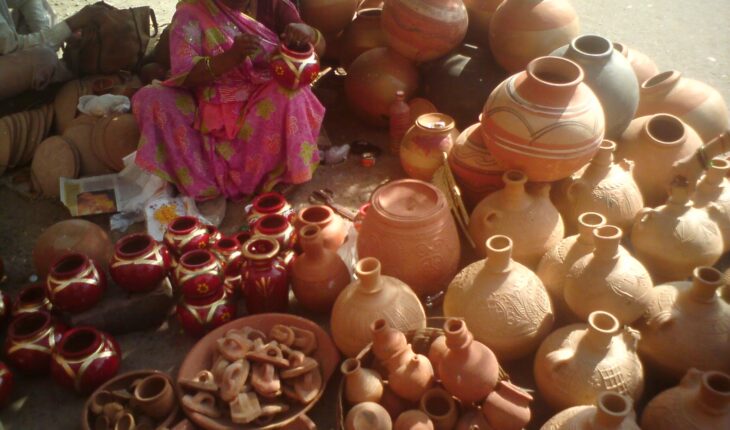
The life of the potter and the pottery makers who give the desired shape to the clay with their fingers on a rapidly rotating wheel is becoming bleak. However, clay pots have many benefits. According to an estimate, pottery has been in use for 15000 years BC. In ancient times, various chronologies were divided using pottery made from clay. During the Neolithic period, pottery was made by hand. The pottery of the Harappan period was colourful and of various shapes. Their colour was usually black and shiny, painted grey etc. Over time, metal utensils replaced earthen utensils.
According to the structure, there are two types of earthen pots. First, permeable, which are water absorbent and second, impermeable, which are not water absorbent. Both permeable and impermeable can be glazed or unglazed. Red and unglazed pots fired at a temperature of 1,000 degrees Celsius or less are called terracotta. Colourful utensils can be made from normal clay without any shine or lustre. Earthen utensils are found in the form of ceramic, clay, pots, pans, terracotta etc.
Earthen pots have been used in India for several thousand years, because there are countless benefits of using earthen pots. According to Ayurveda, if food is to be made nutritious and tasty then it should be cooked in earthen pots on low flame. Due to soil being permeable or porous, there is uniform distribution of heat in an earthen pot, due to which the food gets cooked completely, whereas in a metal pot, there is no uniform distribution of heat. Nowadays, due to obesity or being cautious about health, the demand for non-stick utensils has increased a lot because food can be cooked in less oil in them. However, clay utensils are many times more effective than non-stick utensils. Very little oil is required for cooking food in it. In this, the food items do not stick to the pan or pot. In earthen pots, food gets cooked quickly due to the water present in the food or the moisture present in the pot.
Due to the alkaline nature of soil, it, along with the acid available in the food, controls the pH of the food, which helps us avoid dangerous diseases like cancer. Soil does not allow much heat to penetrate inside it. Due to this quality, clay utensils keep hot foods hot for a longer time and cold foods cold for a longer period than modern utensils. Food kept in earthen pots does not spoil quickly.
To keep our body healthy, a person should consume 18 types of micronutrients daily, which we can get by cooking food in earthen pots. Cooking food in aluminium pressure cooker destroys 87 percent of the nutrients in food. Cooking food in brass utensils destroys 7 percent of the nutrients. By cooking food in bronze utensils, 3 percent of the nutrients are lost, whereas by cooking food in earthen utensils, all the nutrients present in the food remain intact.
Cooking food in aluminium pressure cooker can cause dangerous diseases like TB, diabetes, asthma, paralysis etc., because metal utensils contain many deadly chemicals, which melt when the metal gets heated and mix with the food items. Whereas elements like calcium, phosphorus, iron, zinc, sulphur etc. are found in earthen pots, which together with the food items, make the food tasty and help us in staying healthy.
Earthen pots are environment friendly. If used with care, it can be used for a long time. These are made of soil, break down and get mixed back into the soil, which does not cause any harm to the environment. In India, clay utensils are much cheaper than metal utensils. These are available in all sizes in the market. It also looks beautiful. Wonderful artwork is done on them and the adjustment of colours in the paintings made on them is pleasing to the mind.
In cities, people fear that earthen utensils cannot be cleaned, due to which their use may lead to diseases, but this notion is completely wrong. It is very easy to clean it. There is no need for chemical soap, powder, or liquid for cleaning. Utensils can be cleaned simply by washing them with hot water. To clean greasy utensils, lemon juice is mixed in hot water. Lemon is considered the enemy of lubrication. This makes the utensils completely clean. If someone wants to clean the utensils by rubbing, then he or she can use the outer bark of the coconut i.e., coconut jute. Thus, if anyone wants to use clay pots in their daily life, then they can easily use it.
Morning tea can be drunk in Kulhar. A pot can be kept in the house to cool the water. An earthen plate can be used for eating, an earthen glass for drinking, an earthen pan for making vegetables, an earthen pan for making bread, an earthen pot for making rice, etc. People have this notion that earthen pots can be used only on earthen stoves, but this concept is completely wrong. It can be easily used on gas stove also.
Now the heritage of soil and the fragrance of belongingness is gradually disappearing. The attachment to the soil has been left behind. It is becoming rare to see earthen lamps, utensils, toys, stoves etc., whereas there was a time when potters used to wait eagerly for Diwali and Chhath Pooja. There was huge demand for earthen lamps, deities, utensils, and toys in the market. The potters would start work three months in advance to meet the demands of the customers. There used to be a rush of people to buy clay items in the market during Diwali and Chhath pooja. But in the changing environment, only a few potters are seen making earthen lamps and utensils. Even in summer, people do not use earthen pots to keep water cool. People also do not like to cook food in earthen utensils.
However, by cooking food in earthen pots, both the taste and quality of the food remains intact. Therefore, now dieticians and nutritionists have also started advising to cook food in earthen pots.
Potters have become unemployed today because of neglect of pottery. They have no hope of rehabilitating their traditional profession. Therefore, they have stopped making pottery and started adopting other professions. By the way, it is not just the potters who suffer from the death of pottery. We also suffer from this. It is also dangerous for the environment. Therefore, today there is a need to rehabilitate the potters. The art of making pottery should be kept alive. For this, along with planning for the rehabilitation of potters, there is also a need to implement it wholeheartedly. Our active participation in this process can act as a lifesaver.
Satish Singh, Ahmedabad based Senior Columnist,Views are personal.






